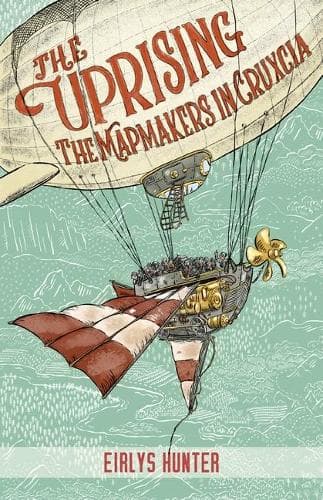Review: The Uprising: The Mapmakers in Cruxcia
Reviewed by Sarah Forster
We join the Santanders as they depart Porto Pearls via dirigible. We rise into the air with the family and soon arrive at their destination, Cruxcia—the last place their missing father was known to be.
The family arrives and after mum and Humphry are wiped out temporarily by bad cordial, the older three children Sal, Joe, and Francie, along with Carrot the parrot, join with local Cruxcians Hessa, Vivi and their friends to begin their adventure in earnest.
The town is being controlled by Moustache Man and the Grania Trading Company (GTC), who have been paying unscrupulous mapmakers Cody Cole and his Cowboys, to create maps around the region for an initially mysterious reason. But Vivi, who is a wheelchair user and the smartest person in any given room, is leading a group of local teens to get to the bottom of it.
Vivi enlists the Santanders to help her to draw a map of their land to prove that it has been held, unbroken, for hundreds of years, in time for the Land Court case in a few days’ time. They particularly want to prove the history of Mina Mendalwar, their sacred hill where their ancestors are buried, where they have seen the GTC construct worker camps.
The adults in the city who were helping to fight against the regime have been put in prison, and this turns out to include the Santanders’ father. So Vivi, her sister and their friends, develop a plan using their joined skills—including Francie’s ability to ‘fly’ and draw—to simultaneously scare the workers on Mina Mendalwar off the hill and release their parents from prison.
While some may remember the previous book The Mapmakers Race as more of a settler story, with little thought given to the caretakers of the land as the mapmakers raced for gold, this one is quite the opposite. Here we have a glorious story of recognition of indigenous land rights for Cruxcians—alongside a story of familial history, and of course some great new inventions along the way (the warm rain room, anybody?).
The author shows the joy of being the citizen of your native land, and the sorrow of colonisation, in a way that is building our critical thinkers of the future. In Porto Pearls, the family see homeless people, while in Cruxcia they observe people creating human barriers to prevent the guards from taking people to jail—protecting those they know, and those they know are on their side.
“Two of the maroon-uniformed men following on horseback dismounted. They strode towards the woman. No one spoke or even looked at her, but suddenly the roadside crowd moved together like a flock of birds or a shoal of fish and Joe, Francie, and Hessa found themselves part of it.”
I enjoyed hearing more from Sal in this book and finding out more about the Santander family’s origins. And the adventure in this book is every bit as exciting as the first. There are terrible discoveries and wild skids down scree slopes, and a fabulous cast of characters, making for a very fulfilling read. Like the previous book, The Uprising is gorgeously illustrated by Kirsten Slade.
Works of fiction have the power to make us reconsider our own worlds. So, I want to leave you with this extract from Vivi’s powerful speech to the judge in the Land Court.
“We are not asking for permission to continue our stewardship of the Afa Valley. We are informing you that we will continue to look after this land into the future.”
Highly recommended.
Reviewed by Sarah Forster
